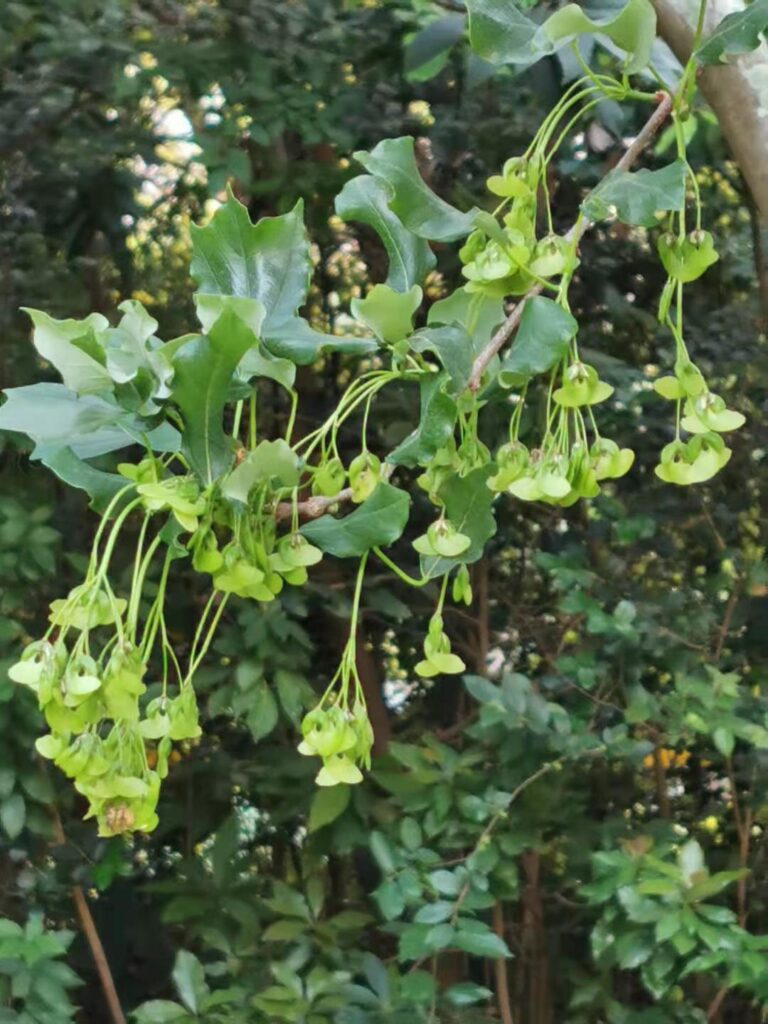There are many types of maple trees, but only one sugar maple (Aceraceae Maple family). All maple trees produce sap which contains sugar, and most can be used to make syrup, but the sugar maple is considered the best for syrup production.
Sugar maple leaves will have a dark green color on the outside, and a lighter green on the underside.
In the fall, sugar maple leaves will lose their green color and take on a beautiful orange, yellow, or red.
Sugar maple leaves are segmented into 5 lobes. There should be three large, main lobes and one
smaller lobe on either side. The lobes are characterized by sharp teeth, and are connected by shallow,
U-shaped notches. Some underdeveloped or stunted sugar maple leaves will have only three or four
lobes. If you see a leaf with fewer than five lobes but suspect the tree is a sugar maple, look around
and find other leaves, which may be better specimens. The leaves of the Silver maple can be
distinguished from those of the Sugar maple. Silver maple leaves have very deep margins between the
five lobes, and the underside is silver or white in color.
Look closely at the edges of the leaf. Sugar maple leaves have smooth, U-shaped margins between
points. The leaves should also be round at the base. The sugar maple is the national tree of Canada
so if you want an indicator of whether or not you are looking at one, compare the shape of your tree’s
leaves to the leaf on the Canadian flag. While many other maples also have smooth margins, the
extremely common red maple has sharp points and serrated or toothed margins between the lobes.
This can be a useful distinguishing feature. The sugar maple leaf stalk (also called a “petiole”), which
connects the individual leaves to the branch they grow on, should be the same length as (or slightly
shorter than) the blades of the leaves. Look for leaves that grow perpendicular, or at a right angle, from
the twig, in pairs. This is called an opposite orientation. Leaves will grow in “sets” of two, with one leaf
always across from another on every twig and branch. Only one leaf should grow from each individual
stem. There will be one vein running through each main lobe, but the two smaller lobes on either side
of the leaf will not have a vein running through them. These veins are detectable on the underside of
the leaf, but lie smooth on top. On the underside of the leaves, the veins may appear slightly “hairy.”
Mature leaves on a sugar maple average between 3 inches (7.72 cm) and 5 inches (12.7 cm) long,
and are equally as wide. If you won’t have a ruler with you in the woods, but are planning to examine
tree leaves, measure a segment of one of your fingers. This can serve as an approximate ruler in the
field. For example, from the tip of your thumb to the first joint may measure one inch.
Identify Sugar Maple by its bark. The bark changes color as it ages. The bark of younger trees will be
grayish-brown in color. As the sugar maple trees mature, the bark will deepen to a dark brown. It is
characterized by vertical grooves that are closely spaced.
The bark can be described as furrowed, and has deep rifts or valleys between each plate of bark.
Sugar maple trees are often confused with Norway maples in Europe and western Asia.
The two are most easily distinguished by their bark: the bark of a young Norway maple is one thin
layer. Over time, Norway maple bark will develop vertical fissures, but they are not as deep and
pronounced as the fissures of the Sugar maple, and do not lift up as much around the edges of the
bark plates. The edges of the plates of bark gradually lift as a sugar maple gets older, and the plates
flake away from top to bottom once the tree has reached maturity. Mature sugar maple trees may
appear “shaggy” from a distance, due to the exaggerated peeling plates of bark that the trees develop.
Inspect the tips of the twigs. They are the small, thin branches that grow out of larger branches, and off
of which the individual leaves grow. Look for twigs that are narrow, sleek, and a reddish-brown color.
The small buds at the ends of each twig should be covered with tiny brown-colored scales. During the
winter months, you may find brown, cone-shaped buds growing along the length of the twigs, in an
opposite orientation, and 1 larger bud growing straight out from the terminal end of the twigs. Twig
buds are also useful in distinguishing Sugar maples from Norway maples. The buds of the Norway
maple are larger than those of the Sugar maple. Norway maple buds are covered in larger purple
scales, which form a rounded tip.
Look for fruit that are green, turning brown when mature in the fall. The leaves are “horseshoe”
shaped, meaning that each fruit has two leaves that grow from opposite sides of the fruit. The flowers
form double-leafed, wing-shaped fruits. The paired “wings”connect at the fruit and are oriented to each
other at a 60 to 90 degree angle. (helicopter effect when flying in the air.) The fruit should measure
about 1 inch (2.54 cm) long, including both “wings.” The wings of a sugar maple grow parallel to one
another. The fruit are technically referred to as “samara,” and may also be referred to as a key. These
fruits are sometimes referred to as “seeds.” However, fruit is the correct designation, as the seeds are
located inside the fleshy tissue of the sugar-maple fruit. Each sugar maple fruit,located between the
two horseshoe-shaped leaves, will have a paired structure. Two distinct fruits, each the size of a small
pea, will look as though they have been fused together in the center of each fruit.






